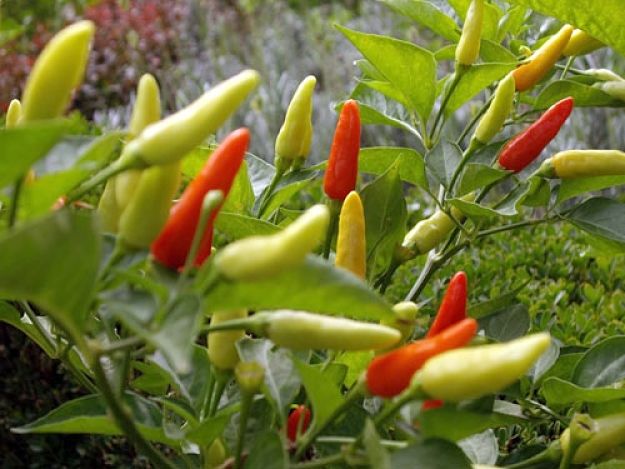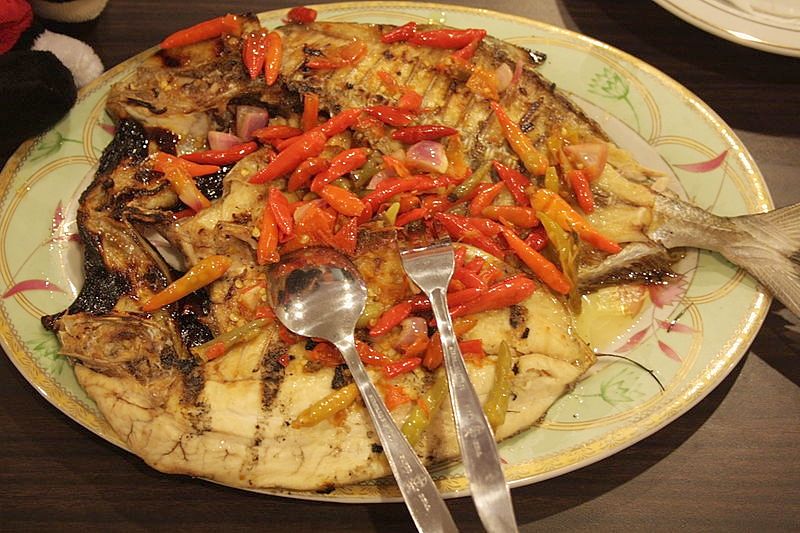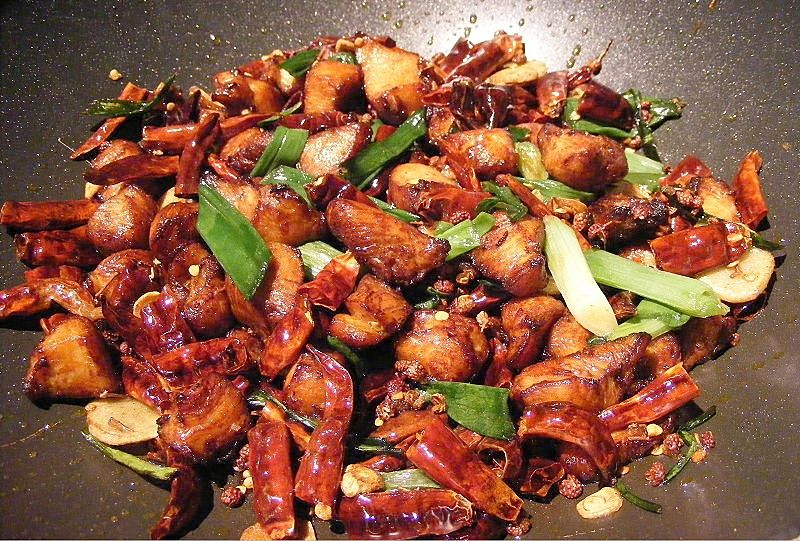What Makes Chillies Hot, List of Hottest Chile Peppers in The World
Humans have been growing hot chilli (chile, or chili) plants for thousands of years. But why do they taste so hot and cause such a violent reaction in the mouth. It is the capsaicin compound in chili peppers that creates the hot taste. This naturally occurring compound doesn't dissolve in water and this explains why it is so hard to wash out of your mouth. It readily dissolves in oils and fats and can be incorporated into hot spicy dishes, sauces and drinks. This is why drinking full-cream milk, not water, can reduce the fiery taste in the mouth. The capsaicin dissolves in the milk fat.
There are specific the pain nerve receptor in the mouth and nose that detect capsaicin and trigger the spicy taste and reaction. These nerves also detect heat and this creates the hotness and burning sensation in the mouth.
Why Did Chili Plants Evolve with Such Fiery Tastes?
Surprisingly, the hottest part of a chilli bulb or fruit is not actually the seeds. It is the 'placenta', the white fleshy tissue that encases the seeds which is the hottest part. Most researchers believe that capsaicin evolved as a deterrent against rats, other rodents, and mammals. Unlike many seeds, the chili seeds are vulnerable and if eaten by a mammal. The seeds are completely digested and destroyed in the guts of mammals. Birds, unlike mammals, are not susceptible to capsaicin and the seeds are not digested in their intestines. So the strategy of stopping rodents may mean that more seeds are eaten by birds and carried far and wide and spread in the bird droppings. It also appears that capsaicin protects the plant against a fungus.
Why Do People Like to Eat Hot Chillies?
Chillies are unpleasant for humans. The capsaicin compound is technically a neurotoxin and is used in pepper sprays by police to disperse crowds and control criminals. Yet more than 2,000,000,0000 people around the globe consume chillies every day. One reason is that the human body releases endorphins in response to the burning sensation. People also like the fiery foods that enhances the taste of meats and other foods. Humans also like sour and bitter tastes. Some people claim that eating chillies is a good way to cool down on a hot day. Other claim that chillies conceal the fact that meat may be rancid or that chillies kill bacteria and ensure the food is safe to eat. These claims have not been substantiated.
Why Do Chillies Taste So Hot?
The nerve cells that detect capsaicin are also sensitive to changes in temperature. This means as well as the 'pain' response they also send a 'hot' signal to the brain. This creates the sensation that your mouth is burning. The more sensitive areas on the body that have more pain receptors are more sensitive to capsaicin. This includes your eyes, lips and hands.
How is the Heat, or Hotness, of Chillies Measured?
Wilbur Scoville, a scientist developed the so called Scoville Organoleptic test in 1912. The test is done through a process of dilution and tasting by volunteers. Precise amounts of Chile peppers are dissolved in alcohol and diluted with sugar water. Various dilutions are tasted until the capsaicin (heat) can no longer be detected. The test units, the Scoville Heat Units (SHU) are expressed as the maximum number of drops of water that need to be added to the measured amount of chili so that it can just be detected. For example a sweet pepper or a bell pepper that contains no capsaicin has zero SHU. Very hot chilis, such as habaneros, have a rating of 200,000 SHU units or higher. This indicates the extract from the chili must be diluted over 200,000 times before the capsaicin can not be tasted or detected. These days modern chemical analysis methods such as those using High Pressure Liquid Chromatography (HPLC) are used because it is much less subjective. However, the results as concentrations of capsaicin are still expressed as equivalent SHU values.
List of the Hotest Chillies and Some Common Sauces
The SHU of various chillies and sauces is shown below with the hottest ones at the top:
Pure capsaicin and Dihydrocapsaicin; 16,000,000 SHU
Nordihydrocapsaicin; 9,100,000 SHU
Homodihydrocapsaicin and Homocapsaicin; 8,600,000 SHU
The Source, from Original Juan Specialty Foods; 7,100,000 SHU
Police grade Pepper spray; 5,300,000 SHU
Trinidad Scorpion; 2,000,000 SHU
Trinidad moruga scorpion; 2,000,000 SHU
Chocolate 7-Pot; 1,800,000 SHU
Trinidad Scorpion Butch T; 1,500,000 SHU
Naga Morich; 1,041,000 SHU
Naga Bhut Jolokia ; 1,000,000 SHU
Red Trinidad 7 Pot; 780,000 SHU
Chocolate Habanero ; 700,000 SHU
Red Savina Habanero ; 500,000 SHU
Spontaneous Combustion Powder; 450,000 SHU
Red Savina; 400,000 SHU
Mad Dog 357 Hot Sauce; 357,000 SHU
Scotch Bonnet; 350,000 SHU
Vicious Viper; 250,000 SHU
Habanero (Capsicum chinense Jacquin); 250,000 SHU
Orange Habanero ; 250,000 SHU
Scotch bonnet (Capsicum chinense); 225,000 SHU
Dave's Insanity Sauce; 180,000 SHU
Birds Eye pepper; 175,000 SHU
Rocoto; 175,000 SHU
Jamaican Hot pepper; 150,000 SHU
Crazy Jerry's Mustard Gas; 125,000 SHU
Carolina Cayenne pepper; 115,000 SHU
Bahamian pepper; 100,000 SHU
Chiletepins, Thai & Birds Eye; 100,000 SHU
Mad Dog Inferno; 90,000 SHU
Tabiche pepper; 90,000 SHU
Red Amazon Pepper; 77,000 SHU
Thai pepper (Capsicum annuum); 70,000 SHU
Chiltepin pepper; 70,000 SHU
Piquin pepper; 50,000 SHU
Super Chile pepper; 45,000 SHU
Santaka pepper; 45,000 SHU
Piquin, Cayenne, Tabasco & Rocoto; 45,000 SHU
Cayenne pepper; 40,000 SHU
Tabasco pepper ; 40,000 SHU
de Arbol pepper; 25,000 SHU
Lottie's Traditional Barbados Yellow; 25,000 SHU
De Arbol, Aji's & Shipkas; 20,000 SHU
Manzano pepper; 15,000 SHU
Serrano; 10,000 SHU
TABASCO brand Habanero Pepper Sauce; 7,500 SHU
Jalapeño (Capsicum annuum); 3,000 SHU
Guajilla pepper; 3,000 SHU
Rocotilla pepper; 2,000 SHU
Ancho pepper; 2,000 SHU
Poblano pepper; 2,000 SHU
Anaheim, Rocotillo, Sandia & Cascabel; 2,000 SHU
Ancho, Pasilla, Mulato & Espanola; 1,350 SHU
New Mexico pepper; 750 SHU
Cherry, New Mexican; 750 SHU
Pimento; 500 SHU
Sweet Bell pepper; 0 SHU

What Makes Chillies Hot. See List of Hottest Chile Peppers in The World
;By Ben3john [CC-BY-SA-3.0], via Wikimedia Commons

Fish Dish with Hot Chillies
By Sanko (Own work) [CC-BY-SA-3.0], via Wikimedia Commons

Stir-Fried Chicken with Chillies
FotoosVanRobin [CC-BY-SA-2.0], via Wikimedia Commons